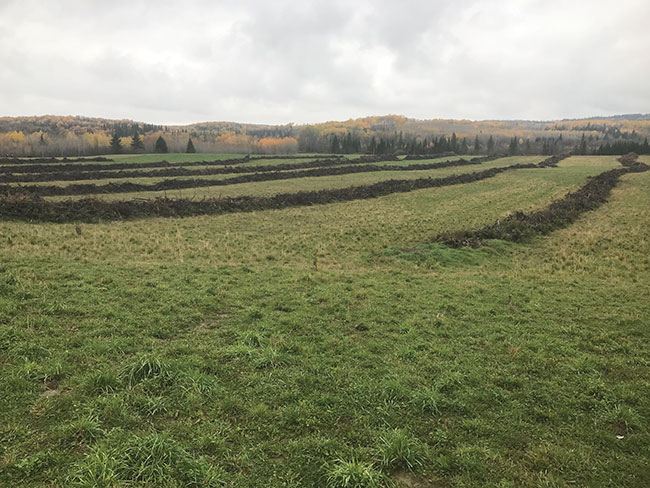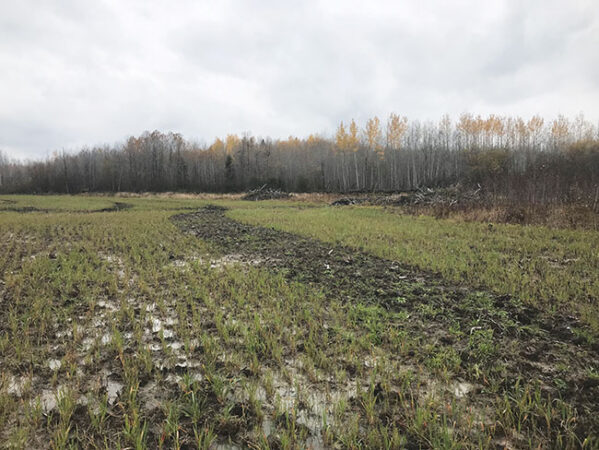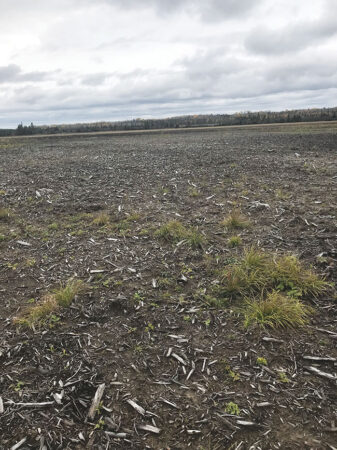
Features
Soil
What’s the best way to go from forests to crops?
Evaluating the sustainability of different land-clearing practices in northern Ontario.
March 6, 2023 By Carolyn King
 An example of conventional clearing where the woody material is windrowed.
All photos courtesy of Amanda Diochon, Lakehead University.
An example of conventional clearing where the woody material is windrowed.
All photos courtesy of Amanda Diochon, Lakehead University. Changes in climate are increasing opportunities for agricultural expansion in northern Ontario, and that will involve conversion of forested land to crop production. But land conversion is a big undertaking. It takes a lot of time. It takes money. And there are multiple ways you can go about it,” notes Amanda Diochon, an associate professor and terrestrial biogeochemist at Lakehead University.
“Farmers really want to protect and enhance their soils. So, they are trying land-clearing practices that keep more soil and more soil organic matter on their fields. In the longer run, that should help their organic matter stores and soil health, but other issues can crop up. Farmers are trying these approaches because it makes sense [for their soil], but at the end of the day, does it ‘make cents?’ We don’t know yet.”
That’s why Diochon is leading a project to examine the end results of different land-clearing methods in northern Ontario in terms of soil health, environmental sustainability and economic profitability.
The project’s funding is from Grain Farmers of Ontario (GFO), Natural Sciences and Engineering Research Council of Canada (NSERC) Alliance, and Lakehead University Agricultural Research Station (LUARS). Diochon is working on this project with Dave Morris, a soil scientist at the Ontario Ministry of Natural Resources and Forestry, and Emily Potter at the Northern Ontario Farm Innovation Alliance (NOFIA), a project partner.
Land clearing and organic matter
“With any land conversion – and this is not limited to northern Ontario – there is typically a decline in soil organic matter contents,” Diochon notes.
“With conversion of forest to agriculture, you’re going to see about a 30 per cent decline in soil organic matter on average.”
As growers know, soil organic matter is important for good soil structure, water infiltration, water-holding capacity and nutrient cycling, which all contribute to a soil’s ability to support crop growth. Consequently, soil organic matter loss can have both economic and environmental impacts for farms.
The amount of organic matter loss is influenced by which particular land-clearing practices are used. Diochon’s project is comparing conventional land clearing and land clearing with mulching, which are the two main approaches being used by northern Ontario farmers these days.
She outlines in broad terms what is involved in each approach. “Conventional clearing involves first harvesting any trees that are worth money. Then you [use a bulldozer to] shear off the residual woody material and pile it up or remove it from the site. You could bring the cleared area into crop production in a year conventionally by shearing everything off and pushing it over to the side of the field. That, of course, is going to be really hard on your soil [especially if the bulldozing step removes a lot of topsoil].
“With mulching, you also start by taking anything that’s worth any money off the site. Then a mulcher goes in and grinds up the remaining aboveground biomass – the trees, shrubs and stumps left behind. And then that mulched material is incorporated into the soil. So, with mulching you’re keeping more soil and more organic matter on the field.”
Within both of those approaches, Diochon is seeing a lot of variation in what farmers are doing across the region. “Based on what I’ve been hearing from farmers, it really comes down to who is doing the work, and how much money you have to spend on it.”
For example, in conventional clearing, sometimes the woody material is piled up and left to decompose, and sometimes the piles are burned and then the burnt material is redistributed across the field. In mulching, different mulcher heads can give somewhat different results. As well, some mulching operators do more intensive mulching than others. She says, “On some fields, the mulched material looks almost like wood chips. In other cases, you’ve got lengths of wood.”
Diochon notes, “Mulching can be viewed as being a way to bring land into production faster. But I’m not sure if that’s the case.”
Although mulching adds more woody material to the soil, even conventional clearing leaves a lot of wood in the soil from the tree roots. And woody biomass material has implications for nutrient availability.
“Wood has a wide carbon-to-nitrogen ratio. That means farmers need to apply more nitrogen to break wood down,” she explains. “So, in the short term, to maintain crop yields, a mulched field will probably require more nitrogen fertilizer than if it had been cleared conventionally. What that means at the end of the day to profit margins is still up in the air.”
She adds, “It’s not necessarily a negative thing to have to apply extra nitrogen fertilizer. I would argue that you would recover some of that nitrogen. The nitrogen is taken up by the soil microbes while they are decomposing the wood. So [when the wood has been broken down], the nitrogen should come back to you in your soil’s bank of nitrogen.”

An example of conventional clearing where the woody material is pushed to the side of the field.
Assessing sustainability
To some extent, Diochon’s project is building on an earlier study by the Temiskaming Crops Coalition, Cochrane Soil and Crop Improvement Association, Ontario Soil and Crop Improvement Association, and NOFIA. That study compared different methods for converting forested land to agricultural production. It resulted in various recommendations and a Land Clearing Guide for northern Ontario farmers (available at nofia-agri.com).
Diochon’s project is looking at some of that study’s recommendations and also digging into the longer term effects of the two land-clearing approaches at locations across northern Ontario.
“The project’s goal is to identify land-conversion practices for agricultural expansion in northern Ontario that maximize profitability and promote economic and environmental sustainability,” she explains.
“To achieve that goal, the project is tackling three objectives: to quantify and compare the effects of different land-clearing practices on soil health and soil organic matter stores; to identify some best management practices for land clearing that maintain and enhance both soil health and crop yields; and to probe into the land-clearing options from a profit margin perspective to identify economical ways to increase the agriculturally productive land base of the province.”
One part of the project involves sampling northern Ontario fields that have been cleared over the last 10 years. According to Diochon, this past decade is when a lot of clearing has been happening in the region and also when mulching has become a more common approach.
“We want to see what farmers have been doing and what the effects are on soil health, and to learn from them about what’s worked and maybe what hasn’t,” she says.
In collaboration with interested farmers, her team has sampled the soils at 10 conventionally cleared fields and 10 cleared fields with the mulch incorporated into the soil. Each of those fields has been paired with a forested area next to the field, which has also been sampled.
The sites are in: the Rainy River area; north of the New Liskeard/Temiskaming Shores area; the Algoma District; and the Thunder Bay area.
They collected the samples from the top 15 centimetres (six inches) of the soil, using the Ontario Ministry of Agriculture, Food and Rural Affairs (OMAFRA) sampling protocol – the same protocol farmers use when sampling for soil fertility testing.
The team is currently analyzing those samples to determine the effect of the land-clearing practices on soil organic matter levels and other characteristics related to soil health.
The other part of the project will involve a greenhouse or field trial to compare the different land clearing options under various crop rotation treatments and fertilizer treatments, looking at the effects on soil health, soil organic matter levels, input costs and crop yields.

An example of land clearing with mulching, showing wood chips in the mulched soil.
Wood incorporation and fertilizer
Diochon is currently finishing up the analysis from another one of her land-clearing studies. This LUARS-funded study was a greenhouse trial that she set up to look into questions like: Does it matter how much wood you incorporate into the soil? How well do the standard fertilizer recommendations work for soils where wood has been incorporated?
“The Ontario fertilizer recommendations work well for a soil that has already been in crop production. But when you have incorporated wood into the soil, applying fertilizer based on what the soil test tells you is not cutting the mustard. I think that may be because of the effects of the decomposition of the wood and the nutrient demands of the organisms that are doing the decomposition,” she notes.
“One of the goals of this greenhouse trial was to see if there is an increase in the size of the microbial community and changes in nitrogen availability in soils where wood has been incorporated.”
For this trial, Diochon and her team first conducted an inventory at a forested site to estimate the amount of aboveground woody biomass available to be incorporated if that site were cleared.
The greenhouse trial’s main treatments were: zero, 25, 50, 75 and 100 per cent of that woody biomass incorporated into soil collected from the site.
Within each of those main treatments was another set of treatments: no fertilizer; fertilizer; lime and fertilizer; and wood ash and fertilizer. The fertilizer was applied at the OMAFRA-recommended rate based on the soil test. The liming and fertilizer treatment was included because the soil was quite acidic. The trial looked at the yields from four successive barley crops.
Although there was quite a bit of variability in the results, the overall finding was that the more wood you incorporated, the more the barley yield decreased.
Diochon will be looking at the data to see how long the barley yields remained depressed after wood incorporation.
Interestingly, the lime and fertilizer treatment actually resulted in the lowest barley yields, whereas in theory it should have had the best yields. Diochon hypothesizes that the increased pH in the limed treatments was better for the microbial community, so their numbers were higher and they increased their competition with the plants for the nutrient supply. If that’s the case, then liming plus higher fertilizer rates could have increased the barley yields.
She also suspects the reason why the yields were better with the wood ash plus fertilizer treatment than the lime plus fertilizer treatment was because wood ash contains phosphorus and potassium, which may also be limiting.
Considering the complexities involved in her research to develop recommendations for crop rotations and fertilizer rates under different land clearing practices, Diochon is very impressed by farmers who are pioneering mulching practices on their own farms.
“Farmers really care about their soils, and they recognize the value in protecting their soils. That’s why they are trying these different approaches. It’s challenging from a research perspective to try and figure out what’s best. They’re living it.”